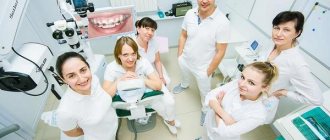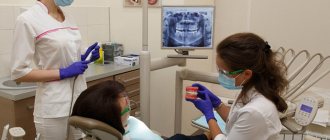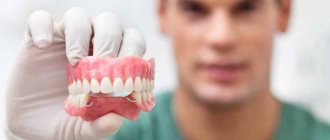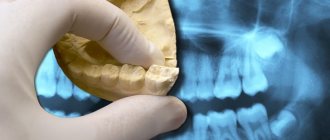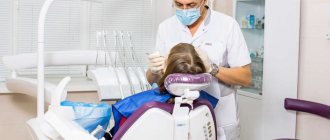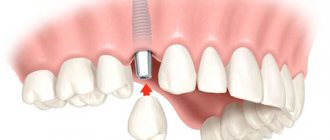An orthodontist is a a person who corrects and eliminates anomalies of the dental system. It is to him that people turn to with similar problems: a protruding jaw, a too narrow chin, crooked incisors, etc. Such a specialist takes on congenital, acquired in childhood and hereditary defects. Moreover, he can work with patients of any age.
Some people believe that correcting the abnormal position of teeth can only be done in childhood. This is wrong. In a child, the treatment process is simpler, but a congenital or hereditary problem can develop in adulthood or worsen over time. If this happens, do not hesitate to contact your doctor.
What diseases does an orthodontist treat?
As already mentioned, an orthodontist deals with congenital, hereditary and acquired dental defects in childhood. This doctor does not work with injuries and does not set the jaw. Most often, an orthodontist is consulted with the following problems:
- facial asymmetry;
- improper growth of teeth;
- violation of chewing functions;
- abnormal position of teeth, etc.
After the examination, the doctor assesses the patient’s condition, studies the causes of the disease and selects a treatment method. Let's take a closer look at the classification of diseases that a doctor encounters.
Anomalies of teeth
Dental anomalies are various deviations of individual elements of the dentition. The following types of abnormal dental development are distinguished:
- violation of shape (spike-shaped, Hutchinson, Fournier, Pfluger teeth);
- non-standard size (micro- and macrodentia);
- too few or too many teeth (edentia, hypodontia, hyperdontia);
- problems with tissue structure (hypoplasia, hyperplasia);
- incorrect timing of appearance (premature or late);
- incorrect position of an individual tooth in the dentition (oral, vestibular, distal, mesial, infraposition, supraposition, rotation around the longitudinal axis, transposition);
- discoloration.
The picture below shows the most common anomalies of individual teeth.
The most common dental abnormalities
Anomalies of the dentition
The dentition can also have anomalies, which sometimes greatly disturb the patient and cause problems with nutrition and speech. The following are the problems faced by orthodontists:
- violation of the row shape;
- incorrect size towards narrowing/widening or lengthening/shortening;
- violation of the sequence of teeth;
- violation of the symmetry of the position of the teeth;
- violation of contacts between teeth (twisted or sparse position).
Malocclusions
Malocclusion is the most common problem that everyone hears. Sometimes patients even get the impression that orthodontics in dentistry deals exclusively with installing braces. Of course, this is not true, but bite correction is one of the most common problems, especially in childhood.
There are five types of malocclusion:
- distal, when the upper jaw is overdeveloped and protrudes forward, significantly affecting facial features;
- mesial, in which the lower jaw is already too developed;
- cross. Its owners have free space between their teeth, and they themselves are arranged “like scissors”;
- deep, in which the lower teeth are practically hidden under the upper ones;
- open, when there is no constant contact between the lower and upper teeth, it appears only in the area of the molars.
An incorrect bite, even if it is not very pronounced, is no less dangerous a problem than a tooth out of alignment or a violation of symmetry.
Malocclusion: main types
You will find detailed information on this topic in the article: All about the bite: what it is like, why it is important to monitor it and how to treat improperly grown teeth
Jaw anomalies
The jaws may also not be positioned quite correctly, is immediately visible to the orthodontist Examples of the most common pathologies:
- altered size (macrognathia or micrognathia), when one of the jaws has reached a much larger size in development than the other. It may be different: the jaws often remain small. The problem may be with only the upper or lower jaw or both;
- incorrect location relative to the base of the skull. There are asymmetric placement, prognathia (strong protrusion forward), retrognathia (movement of the jaw backward);
- abnormal relationship of the dental arches (distal or mesial occlusion, excessive overlap, non-standard occlusions.
The types of disorders of the dental system largely overlap, because, for example, it is impossible to consider the position of the teeth without taking into account the entire dentition. Therefore, if you understand who an orthodontist is in dentistry , then we can say that he is, first of all, a practitioner. He takes into account the characteristics of a particular patient and draws up a completely individual treatment plan.
Who is an orthodontist and does he install braces?
Doctors who eliminate defects in the dentofacial apparatus and correct the position of teeth are called orthodontists. Such a doctor corrects interdental gaps, crooked teeth, incorrect jaw position and much more. In his work, an orthodontist uses braces, plates and other devices that eliminate bite defects.
Orthodontists began to appear in Russia back in the Soviet years. If in those days dentists corrected defects solely according to indications, then in new Russia orthodontic treatment is increasingly used for aesthetic purposes.
The problems with which patients come to the orthodontist are divided into three categories:
- Congenital pathologies associated with underdeveloped teeth, their absence or irregular shape.
- Genetic inheritance, which leads to malocclusion, crowded teeth, large interdental spaces.
- Defects acquired during life, for example, these include crooked front teeth.
Basic methods of orthodontic treatment
Without knowing what exactly the patient came with, it is impossible to say what the orthodontist will do , because the methods of influence primarily depend on the problem and defects in the dentition. Sometimes you can get by with minimal interventions, in other cases you need to involve a dental surgeon.
The most popular methods of dental orthodontism are myotherapy or myogymnastics, hardware treatment and surgical intervention. It is rare that these methods are used in their “pure” form; usually the doctor combines them, forming the course of treatment necessary for a particular patient.
Myotherapy
Myotherapy is one of the ways to strengthen the muscles of the maxillofacial area, thanks to which the formation of anomalies in childhood can be avoided. Based on theoretical calculations about orthodontic treatment, we can conclude that this is the safest and least effective method. Therefore, myogymnastics is almost never prescribed separately.
During classes, the child needs to perform two types of exercises:
- dynamic, when the muscles of the face and jaw sometimes tense and then relax;
- static, forcing the organs to be in tension all the time.
Considering that the exercises must be systematic, classes require adult supervision. Also, it is the parent or teacher who checks that the tasks are completed correctly, because the child may forget or not understand the doctor. The specialist selects tasks, then teaches the adult the exercises, then the adult checks the child.
Myogymnastics class in a children's group: warm-up
Hardware method
The frequency of use of the method clearly shows: an orthodontist is a doctor who treats with fixed and removable hardware systems. The most famous of them are braces, mouth guards and trainers, and plates. When installed, they act on individual teeth, causing them to slowly but surely move in the desired direction. As a result, all elements of the oral cavity occupy their intended position.
Treatment with devices has certain limitations. So, corrections are possible if:
- sufficient force is applied to the tooth, i.e. the equipment is assembled correctly and installed correctly;
- the device has a reliable support and is well fixed;
- there is a place in the dentition into which a stray element can fit;
- there are no obstacles in the path of the tooth being moved.
If these rules are not followed, the dental orthodontist corrects this , and then installs braces, plates or other devices. Sometimes it takes a lot of time to prepare, because it is necessary to remove excess teeth and wait for the restoration of the oral cavity.
Surgical method
If the diagnosis shows that the deformation of the development of the dental arches, jaws or malocclusion is too pronounced, it is necessary to resort to surgical methods. The most popular types of surgical intervention:
- exposure of the crown of an impacted tooth (i.e., removal of the upper gum tissue above a tooth that has not erupted correctly);
- rotation of the tooth around its axis, as a result of which the element falls into place in the dentition correctly;
- removal of individual teeth of irregular shape, extra teeth, as well as those that cannot be “fitted” into the jaw for some reason, etc.
In some situations, surgical intervention falls under the purview of what an orthodontist does . If the specialist cannot correct the situation on his own, he gives the person a referral to a dental surgeon.
What is the difference?
What is the difference between an orthopedic dentist and an orthodontist, read below.
Firstly, the activities of doctors are aimed at correcting various defects . An orthodontist works with dental anomalies, he straightens teeth and improves chewing function. An orthopedist specializes in restoring decaying teeth and installing implants.
If you evaluate Internet queries, it becomes clear that people do not always understand which doctor they need to see - an orthodontist or an orthopedist.
It is worth remembering that orthodontists are found only in dentistry. At the same time, orthopedics is a broader concept, so such a doctor can work not only in a dental clinic. There are orthopedists who deal with problems with the musculoskeletal system.
When to contact an orthodontist
A child should learn who an orthodontist is before the age of 7. At this age, the permanent bite of the anterior incisors is still forming, so it is possible to stop some problems relatively painlessly. Most leaflets for parents contain the following recommendations for visiting a doctor:
- The child is one year old and parents have questions. What does an orthodontist do when the baby has no teeth yet? He examines whether the lips and those teeth that have already erupted are closing correctly;
- child is 3 years old. A visit is advisable, because at a young age, the prerequisites for incorrect development of teeth and jaws can be identified. Therefore, during such an appointment, the orthodontist always asks the parents whether the baby has bad habits, for example, sucking a pacifier, finger, tongue;
- the child has difficulty swallowing, chewing, and speech is not formed;
- you see that the child has changes in the position of the teeth or their closure.
Knowing what an orthodontist does , you can visit a specialist in advance to prevent problems in the development of the dentition and avoid their deterioration.
Pediatric dentist
Treatment and extraction of teeth for patients under 18 years of age is carried out by a pediatric dentist. When working with young patients, the primary task is to find contact with the child and get him ready for treatment, because almost all children enter any medical office with fear. In addition, the children's doctor needs to tell the child's parents how to carry out home oral hygiene for the baby, what products to use, when the physiological change of teeth occurs, etc.
Maintaining dental health from a very early age is necessary for the normal formation of the dental system.
Diagnostics
On average, a diagnosis by an orthodontist takes 30 to 40 minutes, but can take several days. It all depends on the patient’s desire to take certain photographs. Standard procedures included in the diagnostic list:
- visual inspection;
- a panoramic photograph that allows you to see the full view of the jaws, including the roots of the teeth, wisdom teeth, and tooth buds;
- teleroentgenogram (TRG). It allows you to determine the cause of the anomaly, see the relationship of the jaws, and draw a conclusion about what treatment methods will be required;
- 3D scanning or taking impressions of the jaws, with the help of which the exact dimensions of the jaw are determined;
- photographing. It allows you to assess changes in the patient’s appearance and the dynamics of treatment;
- 3D analysis or computed tomography (CT). Required if the doctor suspects a non-standard tooth tilt or other complex problems;
- video recording that allows you to record functional disorders in movement.
Orthopedic dentist
Dental services include dental prosthetics. It is the orthopedic dentist who deals with all types of dental restoration using orthopedic structures. These include:
- crowns;
- bridges;
- veneers, lumineers;
- inlays, overlays;
- mouthguards, splints;
- temporary structures for long-term orthopedic treatment;
- removable and fixed dentures;
- prosthetics on implants.
Stages of consultation and treatment
You need to understand that orthodontic treatment is a long-term process that requires several appointments, or even years of treatment. One visit won't solve anything. The doctor acts as follows:
- First comes the diagnosis, which usually includes not only a visual examination, but also a variety of research methods, for example, orthopantomogram, x-ray, teleradiography. All directions are issued at the first visit.
- Afterwards, the doctor chooses a treatment and prepares the patient for it. The specialist does a lot of work without the client’s participation, for example, everything that an orthodontist does when preparing braces, crowns, etc. The doctor works using photographs, impressions and other tools, analyzing the data obtained during diagnosis.
- The third stage is the installation of hardware in the patient’s oral cavity. This usually doesn't take much time.
- Next comes monitoring how the treatment progresses. If problems are observed, the specialist will correct them in a timely manner.
- The last stage is the removal of devices to correct the dentition.
It is noteworthy that if parents know who an orthodontist is through personal experience, then the child will also most likely get to know this specialist. Many problems, unfortunately, are hereditary.
Dental hygienist
A dental hygienist has a secondary professional medical education. A prerequisite for working as a hygienist is to successfully complete the course “Preventive Dentistry”. What does a dental hygienist do:
- professional oral hygiene;
- treatment of gums with the Vector device;
- whitening;
- provides training in proper oral hygiene;
- selection of personal hygiene products;
- deals with the prevention of gum disease in adults and children.
In short, the main area of work of a dental hygienist is the removal of dental plaque (tartar, plaque). It is important to see a hygienist every six months to maintain oral health.
Conclusions. Expert advice
After reading the material, you understand who an orthodontist-dentist is and why you need to visit him regularly. If we summarize what has been said, we can draw the following conclusions:
- the sooner you see a doctor with a problem, the better;
- It is not necessary to prepare for the visit, but if you tell your child in advance about which specialist you are going to, this will simplify the visit to the orthodontist and make it easier for the child;
- Treatment almost always takes a lot of time, but it gives results.
Gnathologist
Not everyone has heard of this doctor, and this is no accident. This profession is very rare.
This specialist deals with pathologies of the temporomandibular joint. If the patient is bothered by clicking in the joint, pain when opening the mouth, tooth wear, discomfort in the joint when chewing, then it is necessary to contact a gnathologist to eliminate the pathology.
- Pavel
October 7, 2022 at 08:17Thank you for your article, I learned a lot of new things. I had never had any problems with my teeth in my life, so there was no need to understand the areas of dentistry. And now the situation has changed, the first signs of dental ill health have appeared, we have to figure it out. First, I’ll go to my city free dentistry, then maybe I’ll go to a private clinic. Thank you for the clarification
Administrator
October 10, 2022 at 01:37 pm
Hello, Pavla! We are glad that you found the information useful. We invite you to see our specialists if you need dental care.
Features of treatment for children
Many people believe that going to the dentist during the period of baby teeth is not necessary for anyone. The prevailing opinion that temporary crowns will fall out and problems will be solved on their own is fundamentally wrong. It is at the stage of formation of a temporary bite that the foundations of a permanent one are laid.
If a child has problems with the formation of dentition, then this period is the best suited to obtain a positive result in a short period of time. It is worth remembering that the older the child, the longer the treatment will take.
One of the main problems during the period of temporary occlusion or its change may be premature tooth loss. This often leads to displacement of adjacent crowns, malocclusion and difficulty in the eruption of permanent teeth.
To prevent this from happening, the orthodontist installs a temporary crown or spacer that fixes the required distance for the formation of the dentition.
Orthodontic correction in children allows for the normal development of the entire maxillofacial system , the abnormal development of which often leads to the occurrence of common diseases.
For this, braces, special removable plates, mouth guards and other means that do not harm the child are used.
In order to conduct a detailed diagnosis, the orthodontist relies on the following factors:
- type of feeding;
- genetic predisposition;
- timing of eruption;
- the presence of common diseases that provoke dental abnormalities;
- the presence of solid foods in the child’s diet;
- baby's habits;
- sleeping position.
The most appropriate age to begin treatment with an orthodontist is 3 years , until the temporary occlusion begins to affect the formation of the jaw muscles and tooth growth.
Is it difficult to become one?
The work of an orthodontist is very painstaking and hard work, which most often pays quite well. To obtain this qualification, you also need to work hard.
To do this, you need to go through several steps:
- Studying at a medical university at the Faculty of Dentistry.
- Completion of residency or internship in the specialty “orthodontics”.
- Receiving additional training in dental courses.
On average, the main period of study lasts about 8 years.
Comments
At 30 years old, does it make sense to get braces or do I need to undergo another course of treatment? If realistically, then approximately how long will they need to be worn and how effective is this method of treatment for an adult?
Victor (08/14/2018 at 11:36 am) Reply to comment
- Victor, bite problems can and should be solved at any age. As for choosing an orthodontic system that will help most effectively in your case, only an orthodontist can give advice based on examination, diagnosis and condition of the teeth and the entire dental system. And not at the first consultation, but after taking all the necessary parameters. In case of significant pathologies, braces will be one of the best solutions that can correct the situation within 1.5-2 years. It is also important that the braces will be fixed on two jaws at once (as a rule, first on one, and after a few months on the other) in order to even out the bite as a whole. But this depends, again, on the pathology. In any case, consult a doctor, your bite can be corrected!
Editorial staff of the UltraSmile.ru portal (09.17.2018 at 13:22) Reply to comment
Now it’s clear how an orthodontist differs from an orthopedist. I was constantly confused. Tell me, is there data on the effectiveness of various brace systems? I want to install lingual ones, but I’m not sure that they are better than traditional ones.
Olga (08/14/2018 at 12:01 pm) Reply to comment
- Hello Olga! Metal braces give the fastest results; ceramic and sapphire braces last longer. Self-ligating systems also solve the problem very quickly, and they do not require such frequent visits to the orthodontist. As for lingual systems, they are, of course, better than traditional ones in terms of aesthetics - they are completely invisible. But screenings are not for everyone - they can only be performed for certain malocclusion pathologies.
Editorial staff of the UltraSmile.ru portal (09.17.2018 at 14:56) Reply to comment
My adult son, 27 years old, is missing two sixth teeth. The dairy ones fell out, but the permanent ones did not grow. X-rays do not show the presence of new tooth buds. What to do now and where to find an orthodontist who has already solved a similar problem?
Olga (08/14/2018 at 12:08 pm) Reply to comment
- Dear Olga! In general, each tooth has a specific place in the jaw, so displacing some in place of others is a fundamentally incorrect position, because they have a different shape, are designed for a different load, and have different antagonist teeth. Therefore, it is still better to contact not an orthodontist, but an orthopedist who will perform dental implantation or install bridges. This will be a better decision.
Editorial staff of the UltraSmile.ru portal (09.17.2018 at 15:00) Reply to comment
We have encountered an orthodontist more than once, since many relatives in our family have an anomaly associated with teeth - the fangs grow second row, above the teeth. Daughters and nieces about 15 years ago, this problem was “successfully” resolved by surgeons. They just took and removed healthy teeth so that the fangs would fall into place. This is already the second grandson walking around with briquettes. But I'm afraid they turned up too late. Tell me, should we have consulted a specialist before these molars appeared or is it still fixable? The child is 14 years old.
Julia (08/14/2018 at 12:44 pm) Reply to comment
- Hello Julia! This phenomenon is usually called “crowding” and it can indeed be predetermined by heredity. You have already started treatment with braces, so it is more likely to help you. Removing fangs is not an option; aesthetics will be compromised. With this pathology, the distant chewing teeth are most often removed, which makes it possible to free up space for the front teeth. Although everything is individual. And yes, you should have contacted an orthodontist much earlier - you could have started treatment at the age of 6-7 years to correct the situation at the initial stage.
Editorial staff of the UltraSmile.ru portal (09.17.2018 at 15:04) Reply to comment
Unfortunately, when we were growing up, and this is the Soviet “happy childhood”, such specialists were extremely rare, so I live with an incorrect bite, and hence the conclusions, by the age of 45, oral problems have become not only acute, we now have to solve these issues. The orthodontist, as my grandchildren say, is tooth fairies and volebniks, corrected everyone’s malocclusion.
Anna Pavlovna (08/14/2018 at 12:48 pm) Reply to comment
- Dear Anna Pavlovna! Even at your age, it is not too late to solve the problem of malocclusion. There are cases where people were treated with braces at 50 and even 60 years old. The main thing is that there would be living teeth that need to be straightened! Of course, the older the person, the more work will be required - after correcting malocclusion pathologies, it will be necessary to work on the restoration of the teeth, that is, restore their shape. Throughout life, teeth wear down and their chewing surfaces change—this becomes especially noticeable after orthodontic treatment. That is why you will need to visit a therapist and replace the fillings, perhaps even put crowns and core inlays on some teeth. First, visit your doctor! Consultations in many clinics today are completely free and do not obligate you to anything.
Editorial staff of the UltraSmile.ru portal (09.17.2018 at 15:51) Reply to comment
Please tell me at what age can a brace system be installed? My daughter’s teeth are growing crooked and need to be corrected. Different clinics call different ages. Who to listen to?
Alina (08/16/2018 at 14:50) Reply to comment
- Hello, Alina! It is best to begin treatment with braces when the final replacement of baby teeth with permanent ones has occurred. For most children this happens by the age of 13, for some a little earlier - at 10-12. Previously, you could use other means of correction - for example, plates. Note that in some cases, before installing braces, you need to wear certain devices - for example, the same plates. In particular, in order to change the shape of the upper or lower jaws. So it is likely that you can start orthodontic treatment now, before the bite is completely changed and braces are installed.
Editorial staff of the UltraSmile.ru portal (09.17.2018 at 15:55) Reply to comment
As a child, I wore a plate to correct an overbite. But either the plate was chosen incorrectly, or I wore it irregularly, but the bite did not improve. Is it possible to correct a bite as an adult?
Maxim (08/16/2018 at 15:26) Reply to comment
- Good afternoon, Maxim! The bite can and should be corrected at any age. Adults are most often prescribed non-removable orthodontic devices for such purposes, namely braces. The plates are optimal for children under 11 years of age and really require a high level of control and responsibility, if not from the children themselves, then from their parents, because are removable.
Editorial staff of the UltraSmile.ru portal (09.17.2018 at 15:56) Reply to comment
After reading the article, it became easier to see how many ways there are to correct your bite and have a beautiful smile. My son is only a year and a couple of months old, but I have already begun to think about visiting an orthodontist. The baby has a fairly large gap between the upper units. Should I see a doctor now or is it better to wait until all the teeth have erupted? And is there a chance that after all the teeth appear, the gap will shrink?
Anna (08/16/2018 at 15:42) Reply to comment
- Dear Anna! For your peace of mind, you need to show your baby to a pediatric orthodontist. The situation you describe can be compared to a phenomenon called “false diastema.” It can go away when the child reaches two or three years of age when the primary bite is finally formed, or after it is replaced with a permanent one - after all, the permanent teeth themselves are larger in size. Typically, the change from primary to permanent dentition begins at 6-8 years of age, but in any case, observation and control of the situation by a specialist today will not hurt.
Editorial office of the UltraSmile.ru portal (09.17.2018 at 16:00) Reply to comment
I would like to ask if I have heard that frequent teeth whitening can be harmful to tooth enamel. How often should this procedure be done so that the tooth enamel remains strong, but at the same time has the appearance of Hollywood actors?
Vladimir (08/16/2018 at 16:40) Reply to comment
- Vladimir, teeth whitening, if you do it in a dental setting, using professional products, is a safe procedure. It can be repeated every 1-3 years, depending on how long the result lasts. It must be maintained at home - with the help of hygiene and the same professional products that the dentist will individually select for you.
Editorial staff of the UltraSmile.ru portal (09.18.2018 at 14:49) Reply to comment
Please tell me, is it possible for the front teeth to wear off with an incorrect bite? What should I do if my front incisors are half worn away? Is it possible to build up teeth and straighten my bite?
Vladimir (08/16/2018 at 16:45) Reply to comment
- Vladimir, with an incorrect bite, the teeth actually receive a completely uneven load, so tissue abrasion is a normal consequence of such a pathology. You can grow teeth, but first you need to eliminate the cause, namely, malocclusion. Therefore, visit an orthodontist first, start undergoing treatment, and then consult a therapist to restore the aesthetics and shape of your teeth. Otherwise, the treatment will not give the expected result - the teeth will continue to wear out. It is likely that you will also need to get mouthguards for bruxism if you have a similar pathology to protect your teeth from overload.
Editorial staff of the UltraSmile.ru portal (09.18.2018 at 14:46) Reply to comment
Until recently, I had no idea that there were such specialists in dental correction. I'm wondering how the braces system is installed so that it doesn't scratch the enamel of the teeth? In addition, this system still needs to be regulated somehow.
Anatoly Stepanovich (08/30/2018 at 14:49) Reply to comment
- Anatoly Stepanovich, indeed, the profession of orthodontist is very complex, because you need not only to know how the entire jaw system functions, but also to understand how to correct the bite of a particular patient, so as not to harm, but to improve the situation (after all, we are not only talking about crooked teeth, but and incorrectly positioned jaws). As for braces. Their plates actually do not come into contact with the enamel, because they are held on by a special glue (dental adhesive or even composite). The metal arc also does not touch the enamel. Yes, the system needs to be adjusted regularly: ligature braces once a month, self-ligating braces - every 2 months.
Editor of the portal UltraSmile.ru (09.12.2018 at 08:59) Reply to comment
Very useful article. I'm going to see an orthodontist. I was interested in the aligner correction system. I wonder how a system consisting of elastic material can correct the bite? She can't transmit effort.
Anfisa (08/30/2018 at 14:57) Reply to comment
- Anfisa, thank you for your question and for your gratitude to our editors. The material is relatively elastic, and the aligners fit incredibly tightly onto all teeth, so they exert a certain amount of pressure. Small, but still pressure. In addition, each aligner should be worn for about a couple of weeks, during which time the teeth will move slightly. And so on, step by step, gradually, but the bite will change. This entire process is initially thought out on a computer, followed by a thorough diagnosis, study of the condition of teeth and bone tissue, which allows you to design the process from start to finish WITHOUT errors.
Editor of the portal UltraSmile.ru (09.12.2018 at 08:57) Reply to comment
They recommend that I get braces for correction and they say that I will need to wear them for a year. It turns out that a metal structure will be in your mouth for a whole year. The metal will oxidize and oxidation products will enter the stomach and digestive tract. Isn't it harmful?
Nina (08/30/2018 at 15:04) Reply to comment
- Dear Nina! Modern brace systems are created from very high-quality materials that do not oxidize or corrode, especially those created from more expensive metals, such as titanium. Budget analogues mainly use medical steel. You should not choose metal braces if you have an individual intolerance, allergic reactions may occur.
Editor of the portal UltraSmile.ru (09.12.2018 at 08:55) Reply to comment

